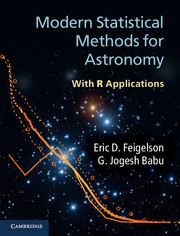Book contents
- Frontmatter
- Contents
- Preface
- 1 Introduction
- 2 Probability
- 3 Statistical inference
- 4 Probability distribution functions
- 5 Nonparametric statistics
- 6 Data smoothing: density estimation
- 7 Regression
- 8 Multivariate analysis
- 9 Clustering, classification and data mining
- 10 Nondetections: censored and truncated data
- 11 Time series analysis
- 12 Spatial point processes
- Appendix A Notation and acronyms
- Appendix B Getting started with R
- Appendix C Astronomical datasets
- References
- Subject index
- R and CRAN commands
- Plate section
3 - Statistical inference
Published online by Cambridge University Press: 05 November 2012
- Frontmatter
- Contents
- Preface
- 1 Introduction
- 2 Probability
- 3 Statistical inference
- 4 Probability distribution functions
- 5 Nonparametric statistics
- 6 Data smoothing: density estimation
- 7 Regression
- 8 Multivariate analysis
- 9 Clustering, classification and data mining
- 10 Nondetections: censored and truncated data
- 11 Time series analysis
- 12 Spatial point processes
- Appendix A Notation and acronyms
- Appendix B Getting started with R
- Appendix C Astronomical datasets
- References
- Subject index
- R and CRAN commands
- Plate section
Summary
The astronomical context
Statistical inference helps the scientist to reach conclusions that extend beyond the obvious and immediate characterization of individual datasets. In some cases, the astronomer measures the properties of a limited sample of objects (often chosen to be brighter or closer than others) in order to learn about the properties of the vast underlying population of similar objects in the Universe. Inference is often based on a statistic, a function of random variables. At the early stages of an investigation, the astronomermight seek simple statistics of the data such as the average value or the slope of a heuristic linear relation. At later stages, the astronomer might measure in great detail the properties of one or a few objects to test the applicability, or to estimate the parameters, of an astrophysical theory thought to underly the observed phenomenon.
Statistical inference is so pervasive throughout these astronomical and astrophysical investigations that we are hardly aware of its ubiquitous role. It arises when the astronomer:
– smooths over discrete observations to understand the underlying continuous phenomenon
– seeks to quantify relationships between observed properties
– tests whether an observation agrees with an assumed astrophysical theory
– divides a sample into subsamples with distinct properties
– tries to compensate for flux limits and nondetections
– investigates the temporal behavior of variable sources
– infers the evolution of cosmic bodies from studies of objects at different stages
– characterizes and models patterns in wavelength, images or space
and many other situations.
- Type
- Chapter
- Information
- Modern Statistical Methods for AstronomyWith R Applications, pp. 35 - 75Publisher: Cambridge University PressPrint publication year: 2012

